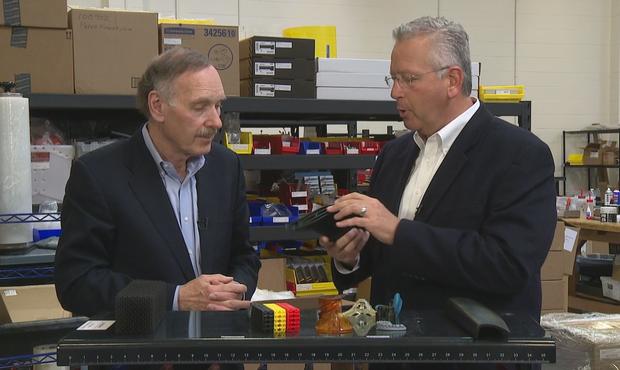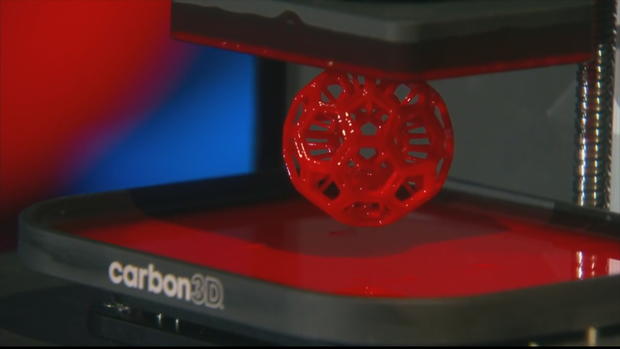Chemist's 3-D printer could open doors for manufacturing revolution
REDWOOD CITY, Calif. --Chemist Joe DeSimone's M1 is a 3-D printer inspired by science fiction.
When DeSimone saw the robot T-1000 rise from a molten pool in "Terminator 2," he imagined a machine that would do something similar.
In a TED Talk last year, he demonstrated an early prototype, growing a complex sphere from a liquid pool in minutes. Now, his company, Carbon, is unveiling its first commercial printer -- a machine capable of making everything from cushioning for running shoes to complex car parts.
"This actually has multiple pieces that was printed all as one part," he said, demonstrating a product to CBS News correspondent John Blackstone.
"This moves, but it was all printed together," Blackstone pointed out.
"That's right," DeSimone responded.
Through the years, factory floors have needed multiple machines, each designed for one specific job, from bolting to soldering to shaping parts. With his new invention, DeSimone imagines nothing less than a manufacturing revolution.
"Think about a place that has 100 of these machines -- and what's really cool is, as you change what products you want to make, you don't have to change the factory floor," DeSimone said.
Until now, 3-D printers have operated by slowly building layer upon layer of material, a time-consuming process used mostly to create prototypes. What other 3-D printers do in hours, the M1 does in minutes -- and not just prototypes, but finished products ready to be used.
The same machine can produce both flexible and hard materials.
"It's all about chemistry," DeSimone said.
The speed and flexibility opens a wide range of possibilities.
"Complex medical devices, whether it's inside of your heart or your kneecap or your feet or your teeth or your ears," DeSimone said.
Legacy Effects studio is one of the lucky few, along with BMW and Ford, given the opportunity to spend months testing Carbon's new printer.
"How is this technology being looked upon in that 3-D printing community?" Blackstone asked.
"They walked up to the industry and dropped a grenade and walked away," Legacy Effects lead systems engineer Jason Lopes said.
Lopes said 3-D printing has been part of their creations for years. But when a commercial needed an Easter bunny on short notice, Carbon's printer provided a faster solution.
"I came in at seven in the morning, printed out the bunny, handed it over by eight in the morning, it was finished painted and brought on set by 10:30 a.m. and shot," Lopes said.
From creatures to practical parts -- "You name it, we make it," Lopes said.
And, in a way, that brings the machine back to its inspiration.
"One of the first projects we did on it was the Terminator Genisys collectibles. How ironic can that be?" Lopes said.
3-D printing was invented more than 30 years ago amid high hopes and plenty of hype. The factory of the future may still be a long way off, but when it arrives, it could be a good example of life imitating art.


